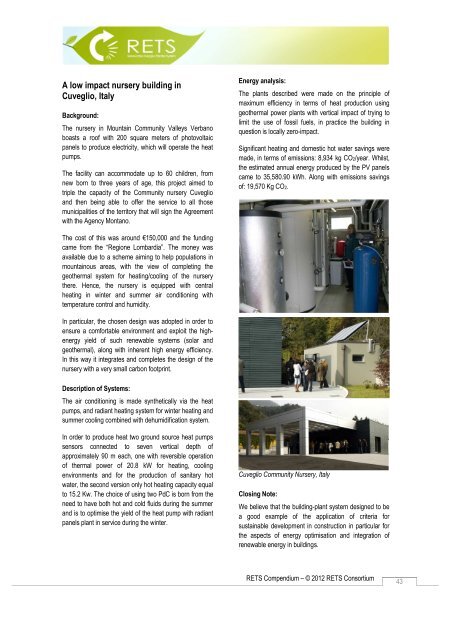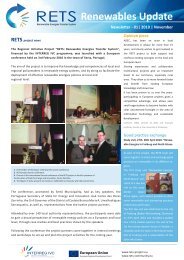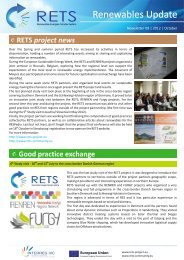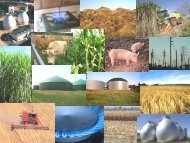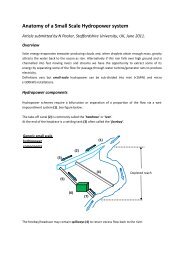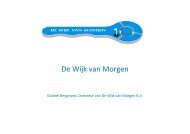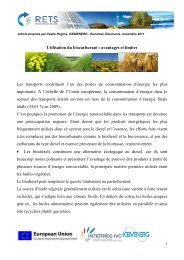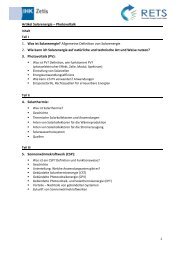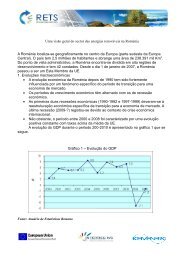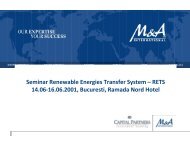Promoting renewable energies - RETS Project
Promoting renewable energies - RETS Project
Promoting renewable energies - RETS Project
Create successful ePaper yourself
Turn your PDF publications into a flip-book with our unique Google optimized e-Paper software.
A low impact nursery building in<br />
Cuveglio, Italy<br />
Background:<br />
The nursery in Mountain Community Valleys Verbano<br />
boasts a roof with 200 square meters of photovoltaic<br />
panels to produce electricity, which will operate the heat<br />
pumps.<br />
The facility can accommodate up to 60 children, from<br />
new born to three years of age, this project aimed to<br />
triple the capacity of the Community nursery Cuveglio<br />
and then being able to offer the service to all those<br />
municipalities of the territory that will sign the Agreement<br />
with the Agency Montano.<br />
Energy analysis:<br />
The plants described were made on the principle of<br />
maximum efficiency in terms of heat production using<br />
geothermal power plants with vertical impact of trying to<br />
limit the use of fossil fuels, in practice the building in<br />
question is locally zero-impact.<br />
Significant heating and domestic hot water savings were<br />
made, in terms of emissions: 8,934 kg CO2/year. Whilst,<br />
the estimated annual energy produced by the PV panels<br />
came to 35,580.90 kWh. Along with emissions savings<br />
of: 19,570 Kg CO2.<br />
The cost of this was around €150,000 and the funding<br />
came from the “Regione Lombardia”. The money was<br />
available due to a scheme aiming to help populations in<br />
mountainous areas, with the view of completing the<br />
geothermal system for heating/cooling of the nursery<br />
there. Hence, the nursery is equipped with central<br />
heating in winter and summer air conditioning with<br />
temperature control and humidity.<br />
In particular, the chosen design was adopted in order to<br />
ensure a comfortable environment and exploit the highenergy<br />
yield of such <strong>renewable</strong> systems (solar and<br />
geothermal), along with inherent high energy efficiency.<br />
In this way it integrates and completes the design of the<br />
nursery with a very small carbon footprint.<br />
Description of Systems:<br />
The air conditioning is made synthetically via the heat<br />
pumps, and radiant heating system for winter heating and<br />
summer cooling combined with dehumidification system.<br />
In order to produce heat two ground source heat pumps<br />
sensors connected to seven vertical depth of<br />
approximately 90 m each, one with reversible operation<br />
of thermal power of 20.8 kW for heating, cooling<br />
environments and for the production of sanitary hot<br />
water, the second version only hot heating capacity equal<br />
to 15.2 Kw. The choice of using two PdC is born from the<br />
need to have both hot and cold fluids during the summer<br />
and is to optimise the yield of the heat pump with radiant<br />
panels plant in service during the winter.<br />
Cuveglio Community Nursery, Italy<br />
Closing Note:<br />
We believe that the building-plant system designed to be<br />
a good example of the application of criteria for<br />
sustainable development in construction in particular for<br />
the aspects of energy optimisation and integration of<br />
<strong>renewable</strong> energy in buildings.<br />
<strong>RETS</strong> Compendium – © 2012 <strong>RETS</strong> Consortium<br />
43


